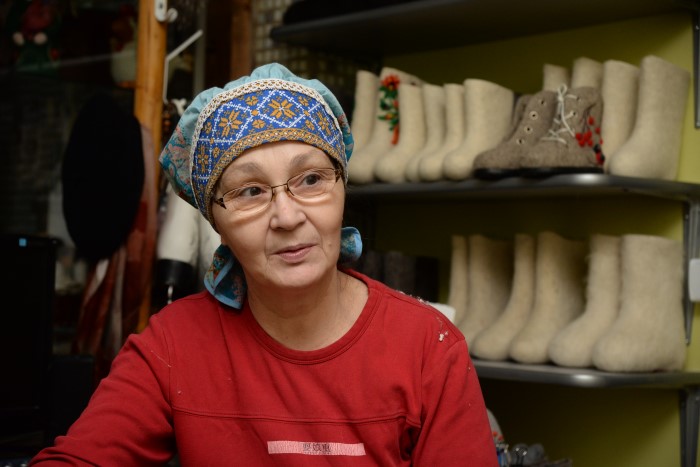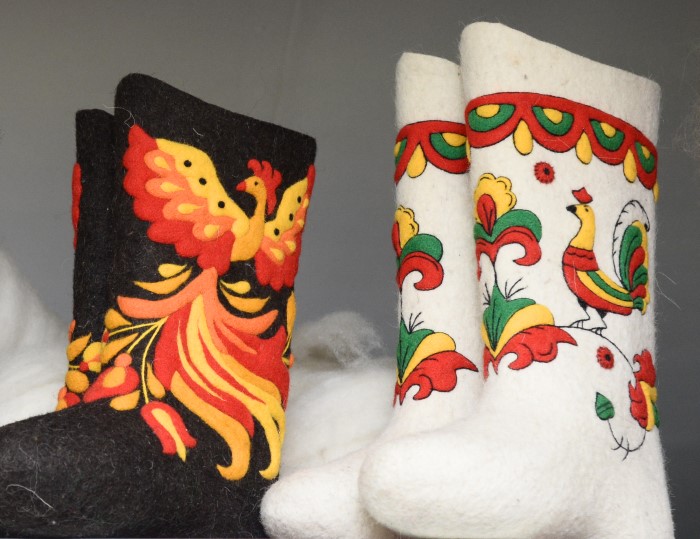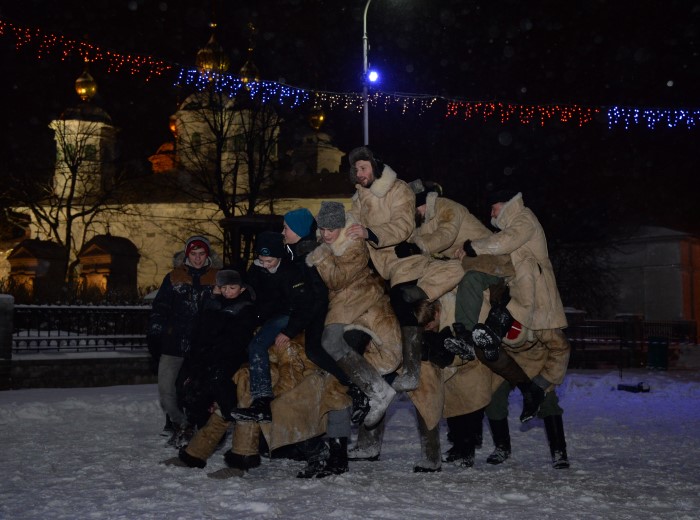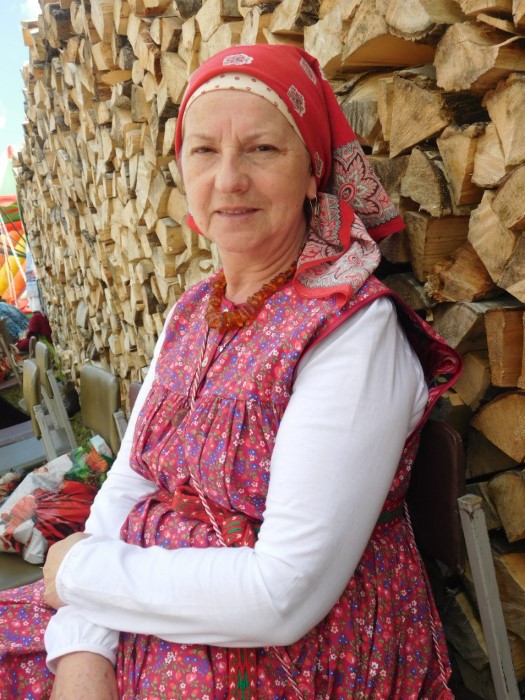
The Latest Fashion From Grandma’s Trunk
/ Главная / Russkiy Mir Foundation / Publications / The Latest Fashion From Grandma’s TrunkThe Latest Fashion From Grandma’s Trunk
The Latest Fashion From Grandma’s Trunk
Traditional Russian clothing is slowly, and imperceptibly to many, returning to everyday use. Even if one doesn’t yet hear the creak of valenki (traditional felt boots) along the dirty city snow or notice designs inspired by sarafans (traditional jumpers) on fashionable dresses, this tendency has already been noticeable in design studios and shops for several years now.
Consumers and designers have been dipping into their grandmother’s trunks to get ideas for weekend and everyday wear. According to craftspeople and specialists in Russian outfits, this new fashion was, surprisingly enough, shaped by the Internet—thought by many to be deadly tradition. “There’s more information out there about authentic Russian culture and old ways of life. People saw the authentic clothing of their ancestors, rather than the outfits worn by popular Russian song-and-dance ensembles, and they became interested,” says Larisa Rozova, an educator and designer from the Vologda Oblast.
Felt Made for Living
When the legendary French actor Pierre Richard was filming in Vologda Oblast several years ago, he walked around for three days in traditional Russian felt boots called valenki. He brought three pairs home from France. (One was a gift and two were bought at flea markets.) He said that he had never worn softer or warmer shoes. And he was very surprised that the locals didn’t wear valenki, although they were sold at every corner in downtown Vologda.

Natalia Kirillova
Most likely, the flea markets that Richard saw were selling valenki made by a Natalia Kirillova, a craftsperson from the out-of-the-way Vologda village of Slizovo. When the jury at the competitive London festival “Ethno Art Fest” awarded her the second prize in the “Ethnic style” category, they most likely thought that these valenki, painted after folk wood designs, were only for display and evaluated them primarily by the drawings on them, rather than how they were cut for wear. But this was a mistake—people walk around in Natalia Kirillova’s valenki all over the country and even abroad. The majority of the articles that she makes in the tiny workshop next to her village hut are distributed at stores and fairs in the Vologda Oblast, but Internet orders come in from dozens of areas in Russia and abroad. The January frost this year triggered a spike in demand, followed by a shortage, for the valenki of this Vologda retiree.
This woman took up making valenki in her retirement. When her children were grown and the cattle shed where she worked saw her off with honors (they didn’t want to let such an experienced cattle-raiser go), she started to look for something to do with herself. Her children gave her a computer, and the worldwide web revealed in Natalia Kirillova a talent for making comfortable felt shoes. On the Internet, she found not only lessons and advice (incidentally, she studied in-person with some craftspeople as well), but also pictures. “If I liked a pattern, I would sew it onto some valenki,” she says. “Indescribable beauty.” Her colleagues have long been skeptical of the valenki this retiree makes, and they will not admit her to a craftsperson’s association. But the buyers go for them, order them, and—most importantly—wear them. Now even London has recognized her.

Valenki made by N. Kirillova
Natalia Kirillova never stops developing her talent, and now she’s working on an urban version of valenki. Her idea is to cross valenki with galoshes and to fashion their outer appearance after elegant boots. She travels to boot makers in the city to learn how to cut, stretch, and pull the leather over the heel and toe. So that no one will see to her buyers: “Oh, what a country girl.”
Where do you buy a sheepskin coat?
Members of the “Buza” boxing club from Cherepovets have dressed for many winters now like the poet Nekrasov’s warmly dressed “little peasant.” When they were preparing for their first fight at the local fair they specially sewed sheepskin coats for the whole club, and then they kept them for everyday wear. Comfortable, warm, loose.
The last “Character of the North” winter festival organized by “Buza” and their friends took place in thirty-below cold, and the most visited venue was a tent with a heater and hot tea. Only the club members didn’t hide from the cold but even undid the top button on their sheepskin coats in order to move more freely.

The “Buza” Artel
“People had dressed up in down jackets and thin-soled shoes, but what good are they against the real Russian cold?” asks the team leader and founder, Denis Antipov. “People simply don’t have proper clothes at home that they can wear outside in any weather without fear. So they either sit at home or run from place to place at a sprint. Is this normal? Where did authentic Russian clothing go? Why was it so quickly forgotten? Now it’s considered exotic, and people come up to us often enough and ask where they can buy a sheepskin coat, thick mittens, and valenki. Can you imagine it?”
In the Vologda region, it’s not unusual for visitors from out-of-town to dress in their “winter clothing” and ride up in expensive foreign automobiles for the Christmas, New Year’s, or even the Shrovetide festivities. After riding up in cardigans and jackets, they would dance in a sheepskin coat or a kazakin (pleated coat), which was lying in the trunk next to the spare tire. Just in case.
Modern Antiquity
Why don’t people wear these clothes in the city, except as playful costumes? They are embarrassed.
“I can understand them,” says a seamstress at the House of Trade, who has studied Russian dress for many years. “Many of us imagine Russian clothing to be the bright, celebratory outfits that we see on television, in pictures, or at the museum. Most of the old clothing that has been preserved is festive wear, because this was what people saved. Of course, if you wear a yellow sarafan [a traditional jumper] and bast shoes, with your hair tied up in a red kerchief, this will draw unwanted attention—like any kitsch. Such things don’t fit into contemporary life. And to get them to fit in, one must find a correct way to join tradition with what people are used to seeing, while also explaining and revealing to people the harmony that our ancestors put into every element of clothing. This is what my colleagues and I are trying to do.”
“I sewed myself a Russian sarafan, which I have already been wearing for several years to work, on walks, on visits—pretty much anywhere,” she continues. “It’s grayish and not immediately perceptible except by its patchwork frills. You have to take a close look. But the sarafan gives me freedom of movement, ease, comfort, and a feeling of safety. It’s difficult to explain.”

A contemporary sarafan
According to Larisa Rozova, an educator and craftsperson at the “Matitsa” folkloric-ethnographic studio, more contemporary women than you would imagine wear subtle “sarafans” sewn based on folk patterns. “Either in the cut, or in the decoration, or in the selection of fabric, many old patterns are returning,” she says. “This is especially widespread in outerwear. For instance, women’s overcoats are sewn to order using a traditional Russian cut. This is pretty, feminine, and looks good on many people. What’s more, it looks very contemporary. Probably because it has mostly been forgotten. As for the men, I know that felt hats are very popular in Yekaterinburg—they wear them on holidays and regular days as well. And in Moscow a certain well-known company sews Russian shirts in an old-fashioned style, which are bought by fashionable tough guys.
In the House of Trade, which is known throughout the Vologda area, Olga Denisova and other craftspeople opened a designer fashion studio in the Russian style called “Zlatoyara,” where they do the sewing themselves and teach the interested how to sew clothing that is neither kitsch nor festive, but made for everyday wear. In these classes, they learn how to cut old village and urban dresses, sarafans, and headwear – and the House of Trade has gathered a rich collection. “There are very many interested in this,” Olga says. “Those who come are not obsessed with fashion, but rather want to revive the woman in them. No more, no less.”
“We take headwear from the lives of our great-grandmothers,” she says. “What variety, what stunning beauty… Not in every modern store can you find the quantity and richness that you find in some village. Society has emphasized the special status of a woman, wife, and mother.”
Sergei Vinogradov
New publications

 Mikhail Kalatozov, a director who transformed the world of cinematography in many ways, was born 120 years ago. He was a Soviet film official and a propagandist. Above all, he was capable of producing movies that struck viewers with their power and poetic language.
Mikhail Kalatozov, a director who transformed the world of cinematography in many ways, was born 120 years ago. He was a Soviet film official and a propagandist. Above all, he was capable of producing movies that struck viewers with their power and poetic language.  Ukrainian authorities have launched a persecution campaign against the canonical Ukrainian Orthodox Church (UOC), the biggest one in the country's modern history. Over the past year, state sanctions were imposed on clergy representatives, searches were conducted in churches, clergymen were arrested, criminal cases were initiated, the activity of the UOC was banned in various regions of the country, and monasteries and churches were seized.
Ukrainian authorities have launched a persecution campaign against the canonical Ukrainian Orthodox Church (UOC), the biggest one in the country's modern history. Over the past year, state sanctions were imposed on clergy representatives, searches were conducted in churches, clergymen were arrested, criminal cases were initiated, the activity of the UOC was banned in various regions of the country, and monasteries and churches were seized.  When Nektary Kotlyaroff, a fourth-generation Russian Australian and founder of the Russian Orthodox Choir in Sydney, first visited Russia, the first person he spoke to was a cab driver at the airport. Having heard that Nektariy's ancestors left Russia more than 100 years ago, the driver was astonished, "How come you haven't forgotten the Russian language?" Nektary Kotlyaroff repeated his answer in an interview with the Russkiy Mir. His affinity to the Orthodox Church (many of his ancestors and relatives were priests) and the traditions of a large Russian family brought from Russia helped him to preserve the Russian language.
When Nektary Kotlyaroff, a fourth-generation Russian Australian and founder of the Russian Orthodox Choir in Sydney, first visited Russia, the first person he spoke to was a cab driver at the airport. Having heard that Nektariy's ancestors left Russia more than 100 years ago, the driver was astonished, "How come you haven't forgotten the Russian language?" Nektary Kotlyaroff repeated his answer in an interview with the Russkiy Mir. His affinity to the Orthodox Church (many of his ancestors and relatives were priests) and the traditions of a large Russian family brought from Russia helped him to preserve the Russian language.

 The leaders of the Friends of the Great Russia cultural association (Amici Della Grande Russia) in Italy believe that the Western policy of abolishing Russian culture in Europe has finally failed. Furthermore, it was doomed to failure from the beginning.
The leaders of the Friends of the Great Russia cultural association (Amici Della Grande Russia) in Italy believe that the Western policy of abolishing Russian culture in Europe has finally failed. Furthermore, it was doomed to failure from the beginning.  Name of Vladimir Nemirovich-Danchenko is inscribed in the history of Russian theater along with Konstantin Stanislavski, the other founding father of the Moscow Art Theater. Nevertheless, Mr. Nemirovich-Danchenko was a renowned writer, playwright, and theater teacher even before their famous meeting in the Slavic Bazaar restaurant. Furthermore, it was Mr. Nemirovich-Danchenko who came up with the idea of establishing a new "people's" theater believing that the theater could become a "department of public education."
Name of Vladimir Nemirovich-Danchenko is inscribed in the history of Russian theater along with Konstantin Stanislavski, the other founding father of the Moscow Art Theater. Nevertheless, Mr. Nemirovich-Danchenko was a renowned writer, playwright, and theater teacher even before their famous meeting in the Slavic Bazaar restaurant. Furthermore, it was Mr. Nemirovich-Danchenko who came up with the idea of establishing a new "people's" theater believing that the theater could become a "department of public education."  "Russia is a thing of which the intellect cannot conceive..." by Fyodor Tyutchev are famous among Russians at least. December marks the 220th anniversary of the poet's birth. Yet, he never considered poetry to be his life's mission and was preoccupied with matters of a global scale. Mr.Tyutchev fought his war focusing on relations between Russia and the West, the origins of mutual misunderstanding, and the origins of Russophobia. When you read his works today, it feels as though he saw things coming in a crystal ball...
"Russia is a thing of which the intellect cannot conceive..." by Fyodor Tyutchev are famous among Russians at least. December marks the 220th anniversary of the poet's birth. Yet, he never considered poetry to be his life's mission and was preoccupied with matters of a global scale. Mr.Tyutchev fought his war focusing on relations between Russia and the West, the origins of mutual misunderstanding, and the origins of Russophobia. When you read his works today, it feels as though he saw things coming in a crystal ball...